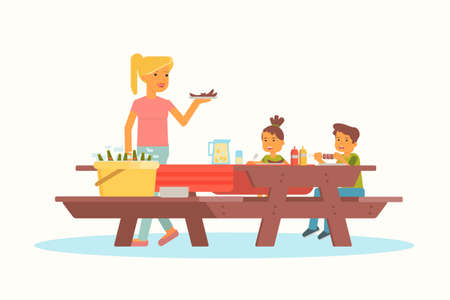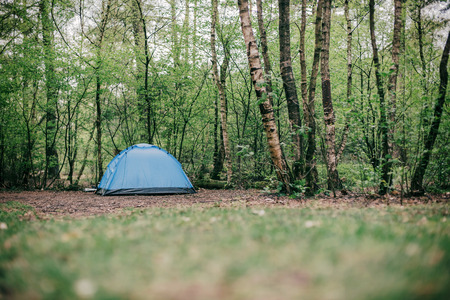1. Understanding the Basics of Outdoor Safety
Before diving into the fun and adventure of camping with kids, it’s important to first go over some basic outdoor safety rules. Teaching children how to stay safe in nature not only helps prevent accidents but also builds their confidence and independence in the outdoors. Here are a few key principles every child should understand before you even pitch the tent.
Staying Within Sight
One of the golden rules when camping with kids is making sure they always stay within sight. Nature can be unpredictable, and it’s easy for a child to wander off without realizing how far they’ve gone. Let your kids know that they should always be able to see or hear an adult at all times. You can even make a game out of it—like calling out a fun word every few minutes to check in!
Recognizing Boundaries
Kids need clear physical boundaries while camping. These could be natural markers like trees or rocks, or items you bring like cones or flags. Walk them around the campsite and show them exactly where they are allowed to explore. This helps avoid getting lost or stumbling into unsafe areas.
Example Boundary Setup:
| Area | Boundary Marker | Rule |
|---|---|---|
| Campsite Perimeter | Colored Flags on Trees | Do not go beyond the flags |
| Fire Pit Area | Rope Circle Around Fire Ring | No entry without an adult |
| Nearby Trail Entrance | Wooden Sign with Kids Name | Stop here and wait for an adult |
The Importance of Adult Supervision
No matter how confident your kids may seem outdoors, adult supervision is non-negotiable when camping. Make sure there’s always a designated adult watching over younger campers, especially near water, fire pits, or during hikes. Assign roles ahead of time so everyone knows who is responsible for what.
Tip:
Create a buddy system where each child is paired with another camper and checks in regularly with an adult. This adds another layer of safety and teaches teamwork too.
By covering these foundational outdoor safety rules early on, you’ll set your kids up for a fun and secure camping experience theyll remember for years to come.
2. Teaching Kids How to Identify and Avoid Hazards
When youre out camping with kids, one of the most important things you can do is teach them how to spot danger and know what to do about it. Nature is full of beauty, but it also comes with a few risks. Helping your child understand these risks will give them confidence and help keep everyone safe.
Wild Animals
Kids are naturally curious, so seeing a wild animal can be exciting—but it can also be dangerous. Teach your child that while animals like raccoons, snakes, or even bears may look interesting, they should always be left alone.
What to Teach:
- Never approach or feed wild animals.
- Make noise when walking through wooded areas to avoid surprising animals.
- If they see an animal, slowly back away and tell an adult immediately.
Poisonous Plants
Plants like poison ivy, poison oak, and poison sumac can cause itchy rashes if touched. Its helpful for kids to learn how to recognize and avoid them.
Common Poisonous Plants in the U.S.:
| Plant | What It Looks Like | Where Its Found |
|---|---|---|
| Poison Ivy | Three pointed leaves, often shiny | Woods, fields, and along trails |
| Poison Oak | Lobed leaves in groups of three | Western U.S., dry areas |
| Poison Sumac | Pinnate leaves with 7–13 leaflets | Swampy areas in the Southeast |
What to Teach:
- “Leaves of three, let it be.”
- If you touch a plant and feel itchy later, tell an adult right away.
- Always wash hands after playing outdoors.
Unstable Terrain
Naturally uneven ground like rocky paths, steep hillsides, or slippery riverbanks can lead to falls or twisted ankles. Teach kids to move carefully and stay on marked trails whenever possible.
What to Teach:
- Watch where you step—avoid loose rocks and wet surfaces.
- No running on trails or near water edges.
- If unsure about footing, ask an adult for help.
Fire Hazards
A campfire is part of the fun, but its also something kids need to treat with care. Whether its the fire pit or portable stoves, make sure they know how to act around flames.
Fire Safety Rules for Kids:
- No playing near the fire or trying to add things into it.
- Keep at least three feet away from any open flames.
- If clothes catch fire: Stop, Drop, and Roll.
- Always have a bucket of water or extinguisher nearby (adult responsibility).
Practice Makes Perfect
The best way to help kids remember safety rules is through practice. Use role-playing games before your trip or during downtime at camp. For example, play a “Spot the Hazard” game where they identify dangers around camp (with supervision). This makes learning fun and memorable!
By teaching kids how to recognize and respond to hazards in nature, youre giving them skills theyll carry with them for life—and making every camping trip safer and more enjoyable for everyone.

3. Creating and Practicing an Emergency Plan
When youre out camping with kids, having a solid emergency plan is just as important as packing enough snacks or bringing the right gear. Kids can get distracted easily in new environments, and if they wander off or get hurt, knowing exactly what to do can make all the difference. Heres how to create and practice a simple emergency plan that your kids will understand and remember.
Teach Kids What to Do If They Get Lost
Start by explaining to your kids that if they realize theyre lost, the best thing to do is STOP: Stay where they are, Think about how they got there, Observe their surroundings, and Plan their next move (which should usually be staying put). Teach them not to run around looking for you—that only makes it harder to find them.
Using a Whistle
Every child should carry a safety whistle on a lanyard around their neck or attached to their jacket. Make sure they know:
- Only use it for emergencies—not for fun.
- If theyre lost or scared, blow the whistle in sets of three blasts—this is a universal signal for help.
- Stop and listen after each set of blasts so they can hear someone calling back.
Identify Safe Meeting Spots
Before setting up camp or going on a hike, walk around with your kids and point out safe places where they can go if they get separated. These could include:
| Location | Why Its Safe |
|---|---|
| The family tent | Easy to recognize and usually central to camp activities |
| The ranger station or park office | Staffed by adults who are trained to help |
| A large landmark like a big tree or boulder near camp | Easy to describe and locate again later |
When and How to Call for Help
If youre in an area with cell service, teach older kids how to dial 911 in case of a real emergency. Make sure they know:
- The name of the campground or trail youre at
- Your campsite number if applicable
- Basic info like your names and any medical needs someone might have
Practice Makes Perfect
The best way to make sure your kids remember these steps is by practicing. Try doing a mock “lost kid” drill once you’re set up at camp. Let your kids blow the whistle (just once!), walk to the safe spot, or talk through what they’d say if calling for help. Keeping it low-stress but consistent helps build confidence—and keeps everyone safer out in nature.
4. Empowering Kids with Basic Survival Skills
When youre out camping with kids, teaching them basic survival skills can make all the difference in an emergency. These lessons not only keep them safer but also build their confidence and independence. The key is to introduce these skills in a fun, age-appropriate way that makes learning enjoyable rather than intimidating.
Building a Basic Shelter
Kids can learn how to create a simple shelter using natural materials or items from your camping gear. This helps them understand the importance of staying dry and warm if they ever get separated from the group.
Simple Shelter Ideas by Age Group:
| Age Group | Shelter Type | Materials Needed |
|---|---|---|
| 5–7 years | Lean-to with tarp | Tarp, rope, nearby trees or sticks |
| 8–10 years | Stick frame shelter | Sturdy sticks, leaves, pine needles |
| 11+ years | Debris hut | Branches, leaves, moss for insulation |
Navigating Using Landmarks
You dont need a compass to teach kids how to find their way. Start by helping them identify natural landmarks like big rocks, unique trees, or even mountains in the distance. Teach them to always be aware of their surroundings and to mentally mark their path as they walk.
Fun Navigation Game:
Create a short scavenger hunt using visible landmarks. Ask kids to remember the route they took and guide you back using those same points. It’s a great way to reinforce awareness while keeping it playful.
Signaling for Help
If kids are ever lost, knowing how to signal for help is crucial. Teach them to stay in one place once they realize theyre lost and use loud noises or visual signals to attract attention.
Ways Kids Can Signal for Help:
- Whistle: Pack a whistle on each child’s backpack. Teach them the “three short blasts” rule as an SOS signal.
- Bright Clothing: Bright colors make it easier for searchers to spot them.
- Signal Mirror or Flashlight: Teach older kids how to use reflective surfaces or flashlights during the day and night.
- Ground Symbols: Show them how to make big shapes like an “X” using rocks or logs to signal from above.
Purifying Water Safely
Finding clean water is essential in any survival situation. While young kids shouldn’t purify water on their own, its still helpful for them to understand why it’s important and how it’s done.
Pocket Guide: How to Purify Water (For Older Kids)
| Method | Description | Best For Ages |
|---|---|---|
| Boiling | Bring water to a rolling boil for 1 minute (or 3 minutes at high elevations). | 11+ |
| Water Filter Bottle | A kid-friendly filter bottle lets you drink directly from streams safely. | 8+ |
| Purification Tablets | Drops or tablets can be used under adult supervision. | 10+ |
| Solar Still (Advanced) | A creative project for teens — uses sun heat to collect evaporated water. | 13+ |
The goal isn’t just survival — it’s about building self-reliance through hands-on experiences. When kids feel prepared, they’re more likely to stay calm and think clearly in unexpected situations. Keep practicing these skills together during your camping trips so that safety becomes second nature.
5. Making Safety Fun and Engaging for Kids
When it comes to teaching kids about outdoor safety while camping, making the learning process fun and interactive can go a long way. Kids learn best when theyre engaged, so turning safety lessons into games, stories, or role-play scenarios helps them retain important information without feeling like theyre in a classroom.
Turn Safety Lessons into Games
Games are a great way to help kids remember safety rules. Whether its a scavenger hunt to find safe and unsafe objects around camp or a “safety bingo” game where they check off things like “wearing sunscreen” or “staying within sight,” these activities make learning enjoyable.
Sample Safety Game Ideas
| Game Name | Description | Safety Concept Reinforced |
|---|---|---|
| Campfire Circle | Kids sit in a circle and take turns naming one campfire safety rule. Repeat until all known rules are said. | Fire safety |
| Safety Scavenger Hunt | Create a list of items that represent safe camping habits (like water bottles, flashlights, or proper shoes) and let kids find them around the campsite. | Preparedness and awareness |
| “What If?” Game | Ask kids questions like “What if you see a bear?” and let them act out the correct response. | Wildlife safety, emergency response |
Use Role-Playing to Practice Real Scenarios
Role-playing is another effective tool. Let your kids pretend they’re in different situations—maybe they’ve wandered too far from camp or found someone hurt on the trail. Guide them through what to do next. Practicing these steps helps build their confidence and memory of the right actions to take.
Tell Stories with a Lesson
Children love stories, especially ones that include adventure and a lesson. You can create your own tales about woodland creatures who follow (or don’t follow) safety rules. Use characters like “Ranger Raccoon” who always tells an adult where he’s going or “Curious Chipmunk” who learns why staying on the trail matters. These stories stick in their minds and give them examples they can relate to.
Pro Tip:
If youre not sure where to start, involve your kids in creating the games or stories—theyll be more invested and excited to participate!
The key is keeping things light-hearted while reinforcing serious messages. By blending fun with education, youre helping your children develop habits that will keep them safe not just during this trip, but for many adventures to come.


